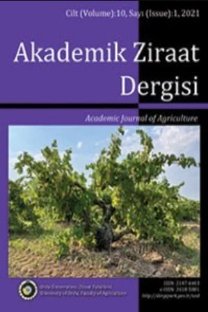Farklı meyve tozları ilave edilen kaşar peynirlerinin renk değerleri ve tekstürel özellikleri üzerine olgunlaşmanın etkilerinin belirlenmesi
Bu araştırmada, biri kontrol örneği olmak kaydıylaaltı tür kaşar peynir üretilmiştir. Kontrol grubuolarak hazırlanan kaşar peynir örneklerine meyveilave edilmemiş olup, diğer beş peynir pıhtısındakullanılan sütün % 3 oranında olacak şekildekurutulmuş, toz haline getirilmiş yaban mersini,kızılcık, siyah üzüm, karadut ve antepfıstığı ilaveedilerek peynire işlenmiştir. Analizler neticesindeelde edilen sonuçlar istatistiksel olarak peynir çeşidive olgunlaşma süresi bakımından karşılaştırılmıştır.Farklı meyve tozları ilavesi, peynirin L, a ve b renkdeğerlerini önemli (P0.05). Fakat esneklik değerlerinde olgunlaşmazamanı yönünden önemli farklılıklar tespit edilmiştir(P
Determination of ripening effects on colour values and textural properties of kashar cheeses with different fruit powders added
In this research, six types of kashar cheese were produced, one of which was a control sample. Fruit was not added to the cheese samples prepared as a control group and it was processed into cheese by adding blueberries, cornelian cherries, black grapes, black mulberry and pistachios, which were powdered to 3% added to the milk used in the other five cheese clots. The obtained results were compared statistically in terms of cheese type and ripening period. The addition of different fruit powders significantly (P0.05). However, significant differences were found in flexibility values in terms of maturation time (P
___
- Cervantes, M.A., Lund, D.B., & Olson, N.F. (1983). Effects of salt concentration and freezing on mozzarella cheese texture. Influence of salting procedure on the composition of muenster-type cheese. Journal of Dairy Science, 66, 204-213.
- Choi, Y.H., Yang, J. C., Choi, S.K., & Bae, I. (2015). Characteistic of gouda cheese supplemented with fruit liquors. Journal of Animal Science and Technology, 57:15.
- Çakmakçı, S., Türkoğlu, H., & Çağlar, A. (1997). Meyve çeşidi ve muhafaza süresinin meyveli yoğurtların bazı kalite kriterleri üzerine etkisi, Atatürk Üniversitesi Ziraat Fakültesi Dergisi, 28(3), 393-404.
- Dinkçi, N., Kesenkaş, H., Seçkin, A.K., Kınık, Ö., & Gönç, S. (2011). Influence of a vegetable fat blend on the texture, microstructure and sensory properties of kashar cheese. Ege University Faculty of Agriculture Department of Dairy Technology, Izmir, Turkey.
- Everard, C., O'callaghan, D., Howard, T., O'donnell, C., Sheehan, E., & Delahunty, C. (2006). Relationships between sensory and rheological measurements of texture in maturing commercial cheddar cheese over a range of moisture and pH at the point of manufacture. Journal of Texture Studies, 37(4), 361- 382.
- Gönenç, S, & Tanrıvermiş, H. (2008). An overview of the Turkish dairy sector. International Journal of Dairy Technology, 61(1), 1-10.
- Günaşekaran, S. & Ak, M.M. (2003). Cheese reology and texture , CRC Press , Boca Raton, Florida.
- Guo, M.R., Gılmore, J.A., & Kındstedt, P.S. (1997). Effect of sodium chloride on the serum pHase of mozzarella cheese. influence of salting procedure on the composition of muenster-type cheese. Journal of Dairy Science, 80, 3092-3098.
- Kaya, S. (2002). Effect of salt on hardness and whiteness of Gaziantep cheese during short-term brining. Journal of Food Engineering, 52(2), 155-159.
- Kim, S.Y., Gunasekaran, S., & Olson, N. (2004). Combined use of chymosin and protease from Cryphonectria parasitica for control of meltability and firmness of cheddar cheese. Journal of Dairy Science, 87(2), 274-283.
- Luo, M.R. (2006). Applying colour science in colour design. Optics and Laser Technology, 38, 392–398.
- Mıstry, V.V., & Kasperson, K.M. (1998). Influence of salt on the quality of reduced fat cheddar cheese. Journal of Dairy Science, 81, 1214-1221.
- Osthoff, G., Slabber, E., Kneifel, W., & Dürschmidd, K. (2011). Flavours and flavourants, colours and pigment. processed cheese and analogues, First Edition. Edited by A.Y. Tamime. Blackwell Publishing Ltd. Published by Blackwell Publishing Ltd.
- Pastorino, A.J., Hansen, C.L., & Mcmahon, D.J. (2003). Effect of salt on structure-function relationships of cheese. Journal of Dairy Science, 86, 60-69.
- Petrovic, J., Glamočlija, J., Stojković, D., Ćirić, A., Barros, L., Ferreira, C.F.R.I., & Soković, M. (2015). Nutritional value, chemical composition, antioxidant activity and enrichment of cream cheese with chestnut mushroom Agrocybe aegerita (Brig.) Sing. Association of Food Scientists & Technologists, 52(10), 6711–6718.
- RapHaelides, S., Antoniou, K., & Petridis, D. (1995). Texture evaluation of ultrafiltered Teleme cheese. Journal of Food Science, 60(6), 1211-1215.
- Şalvarcı, M. (2015). Farklı pH değerlerindeki telemelerden farklı üretim teknikleriyle üretilen kaşar peynirlerinin bazı özelliklerinin belirlenmesi. Yüksek Lisans Tezi, Selçuk Üniversitesi, Fen Bilimleri Enstitüsü, Gıda Mühendisliği Anabilim Dalı, Konya.
- Singh, K., Mishra, S., & Prasad, M.V. (2017). Effect of different ratio of pineapple and apple pulp on quality and shelf life of blended cheese, International Journal of Chemical Studies, 5(4), 1212-1216.
- Temiz, H. (2009). Effect of modified atmosphere packaging on characteristics of sliced kashar cheese. department of food engineering. Engineering Faculty University of Ondokuz Mayis. TR-55139 Samsun, Turkey
- Tunick, M. H., K. L. Mackey, P. W. Smith, & V.H. Holsinger. (1991). Effects of composition and storage on the texture of Mozzarella cheese. Netherlands Milk and Dairy Journal, 45, 117-125
- Ünsal, A. (2003). Süt Uyuyunca: Türk peynirleri, 3. Baskı Yapı Kredi Yayınları, İstanbul.
- Yerlikaya, O., & Karagözlü, C. (2014). Effects of added caper on some physicochemical properties of White Cheese. Mljekarstvo, 64(1), 34-48.
- Zoon, P. (1991). The relation between instrumental and sensory evaluation of the rheological and fracture properties of cheese (pp. 30 - 35). In: Rheological and Fracture Properties of Cheese. IDF Bulletin No: 268, Brussels, Belgium.
- ISSN: 2147-6403
- Yayın Aralığı: Yılda 2 Sayı
- Başlangıç: 2012
- Yayıncı: Ordu Üniversitesi Ziraat Fakültesi
Sayıdaki Diğer Makaleler
Orman ve mera alanlarında oluşan toprakların sınıflandırılması: Kabadüz/Ordu
Atilla AKBULUT, Şevket Metin KARA, Aysel ÖZCAN
Seyithan SEYDOŞOĞLU, Nizamettin TURAN, Aylin OLUK
Karayemişte Siyanür İçerikli Amigdalin ve Prunasin Miktarlarının Belirlenmesi
Bazı silajlık mısır çeşitlerinde (Zea mays L.) verim ve kalite özelliklerinin belirlenmesi
Nuri YILMAZ, Osman AKMAN, Özlem ÖNAL AŞCI
Halil İbrahim BENLİ, Muharrem TÜRKKAN
Biochar Uygulamalarının Ekmeklik Buğdayın Kadmiyum (Cd) Alımına Etkisi
Bazı önemli dış mekan süs bitkilerine ait yeşil çeliklerin köklenme performansları
Toprak koruma uygulamalarının maliyet fayda analizi: Nijerya için bir vaka çalışması
